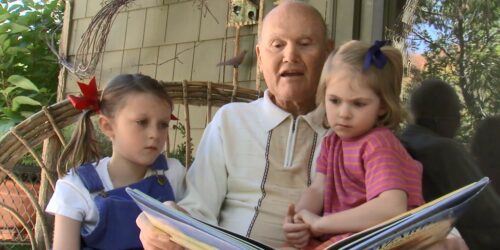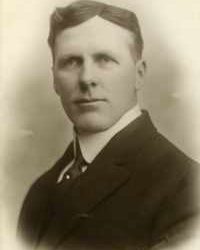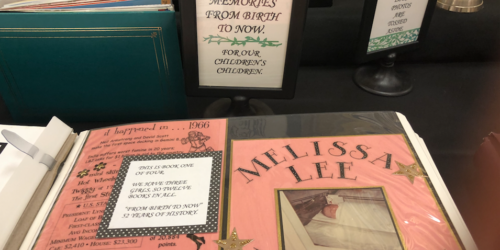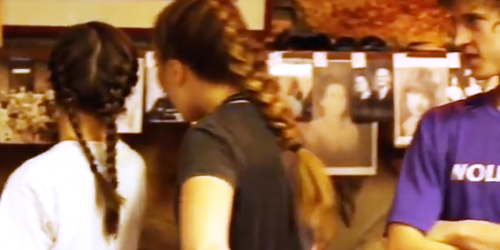Collect the Stories of the First Converts in Your Family Lines
Elder William A. Walker in general conference, April 2014, stated:
I love Church history. Perhaps like many of you, my own faith is fortified when I learn of 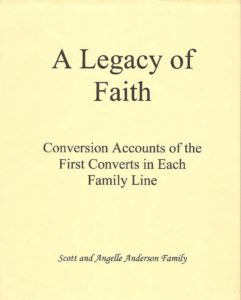 the remarkable dedication of our forefathers who accepted the gospel and lived true to the faith…
the remarkable dedication of our forefathers who accepted the gospel and lived true to the faith…
It would be a wonderful thing if every Latter-day Saint knew the conversion stories of their forefathers.
Whether or not you are a descendant of pioneers, the Mormon pioneer heritage of faith and sacrifice is your heritage. It is the noble heritage of The Church of Jesus Christ of Latter-day Saints. Live True To The Faith
One idea is to make a collection of the conversion stories of the first family members to join the church in each of your ancestral lines. Make a book of these stories for your family (bind, put in a notebook, and/or share digitally). Send this collection of stories with your missionaries — they are usually asked to bring family history stories with them. Give as gifts. Put these stories on familysearch.org and attach them to your tree! Find instructions here.
Following are snippets of the conversion story of my 3rd great grandparents on my father’s side. I love to share it because it is one of the first that I remember hearing and receiving strength from as a child, and the 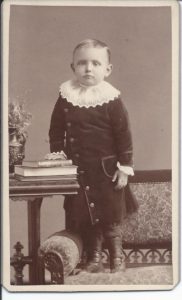 inspiration has continued throughout my life. The wardrobe closet that their son (my 2nd great grandfather) Niels Rasmussen built completely without nails stands in the master bedroom of our home. This photo is of Niels as a young boy in Denmark.
inspiration has continued throughout my life. The wardrobe closet that their son (my 2nd great grandfather) Niels Rasmussen built completely without nails stands in the master bedroom of our home. This photo is of Niels as a young boy in Denmark.
Note: The Family History Guide “FamilySearch Memories” (Project 2) has step-by-step instructions for preserving your Photos and Stories.. These stories are from my gallery in FamilySearch.
Hendrik and Rebekka (Hansen) Rasmussen were devoutly religious people, the pride of whose life was the older of their 2 sons and had they not just reason for their pride? Not every farmer had a son who was studying for the Lutheran Ministry as was Peter. What a servant of the Lord he would make! The hearts of even the youngest sisters and brother glowed at the thought. When Kirstine was about 15 years old, some Mormon missionaries came to the village where the Rasmussen’s lived. The good people had heard of these terrible preachers but had never seen any. Mother Rasmussen warned her little family of the perils of even looking at a Mormon, but in spite of her precautions, Peter heard the message of the missionaries, and it set his religious heart aflame. He dared not mention the gospel to his parents, but Kirstine was different. She would never betray him, but would listen sympathetically. Kirstine made a wonderful confidante, and soon she was skipping out with Peter to go to the forbidden meetings. They were very happy in the new-found gospel until their parent discovered their secret. Such a violent berating has they received on their buckless young heads! They were forbidden in the strongest terms to have nothing more to do with the vile Mormons “Would you disgrace us, Peter, and you studying to be a minister?” was the stern reprove of the father. The brother and the sister suffered greatly from their parent’s edict. At first, they tried to explain what they had learned, but the mother became hysterical at the very mention of the gospel. Matters did not improve and finally, calamity struck the Rasmussen’s. The mother was stricken with sudden, terrible paralysis. Not a muscle could she move nor could she speak except from agonized beseeching eyes. The family doctor worked with her, but finally despaired from helping her. The family stood about in helpless misery till Peter timidly suggested that the Mormon elders were said to have miraculous powers of healing. Kirstine added her voice to his pleading till stubborn old Hendrik, humbled by his wife’s illness, consented to have the missionaries called. He could not help being struck by a feeling of peace that accompanied the two men who came so willingly to the stricken home. The awe inspired family stood about the mother’s bed as the missionaries administered to her. As they took their hands from her head, she spoke suddenly, saying, “Look! I can move my thumb!”. Recovery was rapid from that moment and soon the mother was going thankfully and happily about her work. The missionaries were welcomed and eagerly listened to from that time on, and soon the Church had some new members. The urge to come to Zion became very strong in the Rasmussen’s, so they made their plans to come to America, but before they could start, the good father had his back broken in an accident and died. In 1866, three years after the death of her husband, his mother succeeded in raising enough money to take them to Utah. On May 10, 1866, in company with a number of other neighbors, who had also joined the church, they left all that was near and dear to them–relatives, friends, associates, and their home. Included in the relatives was his maternal grandmother who was then 81 years old. He disliked very much leaving her behind. Peter’s younger brother, Niels was only 12 years old at the time they left.
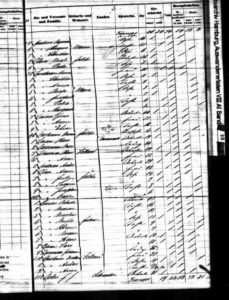 They arrived in Copenhagen on May 11th, and had to stay about two weeks. On May 28th, they left Copenhagen on the steamship, Aurora, for Kiel, Germany, and arrived there the next day. They left Kiel for Hamburg, Germany, and set sail on the sailing vessel, Cavour, May 29th, his twelfth birthday anniversary bound for New York. They arrived in New York after a tedious voyage of nine weeks and three days, due to bad winds. They stopped at Castle Gardens, an old theater used for emigration purposes, a few hours and then set sail on an American River steamer for Albany. They sailed all night and in the morning they boarded a train for the West.
They arrived in Copenhagen on May 11th, and had to stay about two weeks. On May 28th, they left Copenhagen on the steamship, Aurora, for Kiel, Germany, and arrived there the next day. They left Kiel for Hamburg, Germany, and set sail on the sailing vessel, Cavour, May 29th, his twelfth birthday anniversary bound for New York. They arrived in New York after a tedious voyage of nine weeks and three days, due to bad winds. They stopped at Castle Gardens, an old theater used for emigration purposes, a few hours and then set sail on an American River steamer for Albany. They sailed all night and in the morning they boarded a train for the West.
About this time cholera had begun to appear and several people had died of the dreaded disease. It continued to spread at a “terrible rate of slaughter” on the railroad. It was no respecter of persons, as “men in their prime of life and apparently hale and hearty were stricken down, never to rise again.” When they arrived at St. Joseph, Missouri, they sailed up the Missouri to Wyoming. Out of the company, numbering two hundred and eighty souls, eighty of all ages had died.
They arrived in Wyoming and stayed there for two days, and then started for Utah. His only brother, Peter, nineteen years of age, took sick with cholera and suffered “the most terrible pain and excruciating torture”. “It was heart-rending to hear him cry in his agony”, said Niels. His mother grieved about Peter. She waited on him and did all she could to alleviate his suffering until she took sick with cholera. Peter died and a few days later his mother followed him.
Grief and worry nearly crazed Kirstine as she realized her responsibilities as the oldest of the five remaining children . She and her charges hovered, inconsolable, over the bodies of the beloved ones all ready for burial. As they wept bitterly the mother opened her eyes and was permitted to come back and speak to this daughter and (as we gather from the records we have), “I can’t stay long. I have to go back. It is a beautiful place on the other side. If I had known that it was such a beautiful place I would not have mourned for my son. Don’t grieve for us for we will be well-cared for. Never leave the church. It is the true church.” As she admonished them to remain faithful to the gospel as long as they lived, she told them that this brief return was to be a testimony to them, and to their children, and to their children’s children, and added, “Take care of your brother and sisters.”
Like the other dead, her mother and brother were buried in a shallow grave by the roadside, after being sewn up in sheets. They did not have the privilege of seeing Utah, their greatest desire. The family traveled in the ill-fated company in charge of Captain Abner Lowry, who was ably assisted by Brother George Farnsworth of Mt. Pleasant, Utah. Niels said, “We will never forget the untiring efforts of Brother Farnsworth in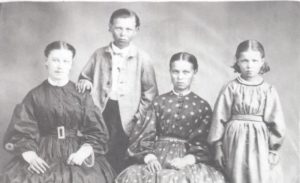 alleviating the sufferings of those afflicted with cholera”.
alleviating the sufferings of those afflicted with cholera”.
A relief mule train, under Captain Arza E. Hinckley, sent out by President Brigham Young, met them about 400 miles east of Salt Lake City. All the orphans, of which there were many, were taken by that train. Included in the orphans were Niels and his four sisters who were all placed in separate homes of willing saints. This photo is of them when they arrived in the valley, October 8th, 1866, while the main company, which lost nearly all of their cattle in the snow in the mountains, reached the valley two weeks later, October 22, 1866.
Niels Rasmussen was active in the church. In the First Ward he was Ward clerk for a number of years, Superintendent of the Sunday School from December 1886 to 1901,  Second Counselor to Bishop Joseph Warburton from October 27, 1897 to June 1, 1909 when the Ward was divided, forming Emigration Ward.
Second Counselor to Bishop Joseph Warburton from October 27, 1897 to June 1, 1909 when the Ward was divided, forming Emigration Ward.
He married Laura A. H. Thorup September 11, 1879 and Christine V. Thorup November Presiding Bishop’s Office in March, 1909, he began dry-farming in Welby, Utah and made a success of it. All the farmers of longstanding said he taught them how to become successful dry farmers.
Presiding Bishop’s Office in March, 1909, he began dry-farming in Welby, Utah and made a success of it. All the farmers of longstanding said he taught them how to become successful dry farmers.
He died March 6, 1914 in Salt Lake City, Utah, at the age of 59 years, 9 months, and 8 days. He was the last survivor of his father’s family and lived a busy and useful life.
–From records written: March 10, 1940

